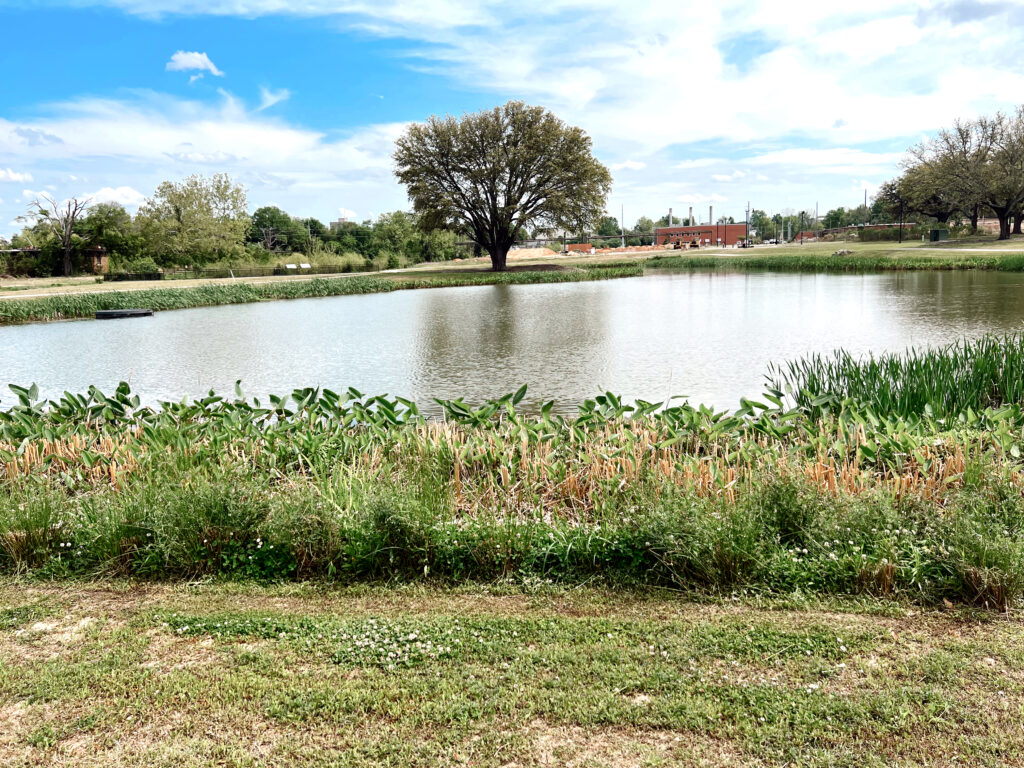The Revitalization of Page Ellington Park Brings New Ecosystem to BullStreet

The crown jewel of the BullStreet District is Page Ellington Park, a 20-acre public park that features running and walking paths, a dog park, a natural water habitat and its own thriving ecosystem.
Located along Gregg Street between Colonial Drive and the Central Energy event venue, Page Ellington Park is managed by the City of Columbia Parks and Recreation Department after being designed, constructed and gifted to the city by Hughes Development Corporation, the master developer of the BullStreet District.

The heart of the park features a two-acre pond and Smith Branch Creek, 2,600 linear feet of which have been daylighted or newly restored as part of the BullStreet District revitalization.
“We are the recipient of this phenomenal gift,” says Ranger Karen Kustafik, Assistant Superintendent for Environmental Services for the City of Columbia’s Parks and Recreation Department. “There is truly no comparison to it. Our responsibility as park rangers is to maintain and protect the park.”
Ranger Karen oversees a staff of 30 park rangers, some of whom are responsible for the maintenance and conservation of the Page Ellington Park.
Visitors can take a self-guided tour and find educational signage explaining all of the inner workings of the ecosystem.

The BullStreet subwatershed is one of 13 in the Smith Branch watershed, which is an area of land that drains to one point. The BullStreet subwatershed is the most urban of the 13 with 59% impervious surface — a hard or compact surface like asphalt and concrete that do not let water seep into soil. The improvements to the portion of Smith Branch Creek that runs through the BullStreet watershed improves the quality of the water flowing into the Broad River.
Part of the park’s revitalization was daylighting parts of Smith Branch Creek. Daylighting is the process of bringing the stream that was piped underground back to the surface, restoring both creek and floodplain. The benefits of daylighting are astronomical: it reduces pollination in runoff and improves water quality, it reduces flash flooding allowing water to expand into floodplains and it provides a habitat for vegetation, amphibians, pollinators and birds.

The upstream portion of the creek (above the weir, more on that later) has always been above ground but was in poor condition before development. It was reconstructed to be ‘wild and messy’ to restore habitat for wildlife.
A weir is a type of dam with water that flows over the top. Page Ellington Park’s weir separates the upstream from the rest of the creek directing flow into the new lower stream.
During heavy rain, excess water from upstream flows over the weir and into the culvert pipes. If the pond gets full, it also flows into the culvert pipes. The pipes hold extra water, preventing flooding downstream in Smith Branch Creek.
The lower stream of the newly reconstructed creek provides a habitat for native flowers, shrubs and trees. It is gently sloped to hold storm water and lower flood flows to levels that are better than pre-development conditions. “The banks are wider to allow water to come up into the floodplain, and it’s more inviting, too,” Ranger Karen says of the lower stream.
The wetland portion of the creek holds extra water during storms. The plants filter pollutants and allow sediment to settle to the bottom. Water from the wetland flows downstream under Colonial Drive.

Columbia Parks and Recreation work to maintain the environment and ecological integrity of the space. This includes making the park a safe place for the many plants and animals that inhabit and visit it, including red-winged blackbirds, great blue herons, orchard orioles, blue jays, yellow-throated warblers, bullfrog tadpoles and more.
“We’re just at the beginning [with the park]. This can only get better,” says Ranger Karen. “Plants will continue to divide and grow. We will see nature really use this place.”
The flagship pond is surrounded by four species of native plants: Juncus grass, Virginia iris, Pickerelweed and Alligator flag. All of these species create a natural barrier along the pond. You can also find many different species of frogs living among them.

There have also been more than 3,500 live stakes planted — essentially, small branch cuttings that will turn into thriving trees, plants and shrubs — throughout Smith Branch Creek since the revitalization began. Some of these species include shrubby dogwoods and black willow trees.

The park is also home to a beloved dog park. On any given day, dogs of all shapes and sizes can be seen frolicking inside its fence.
There are two shelters in the park as well. They can be used for anything from gatherings to a shady place to read a book.
The park was named in 2021 for a prominent, Reconstruction-era African American architect and builder, Page Ellington. Ellington was instrumental in erecting many of the buildings for the state hospital campus, including The Babcock Building. According to research by Historic Columbia, Ellington was a ‘brick mason or carpenter’ in the late 1800’s. Ellington was publicly given credit for his craft by Dr. James W. Babcock which was an uncommon occurrence for Black artisans at the time. He received praise in his skilled design and construction work in many projects around Columbia.
Page Ellington Park is open to the public to use and enjoy.
You must be logged in to post a comment.